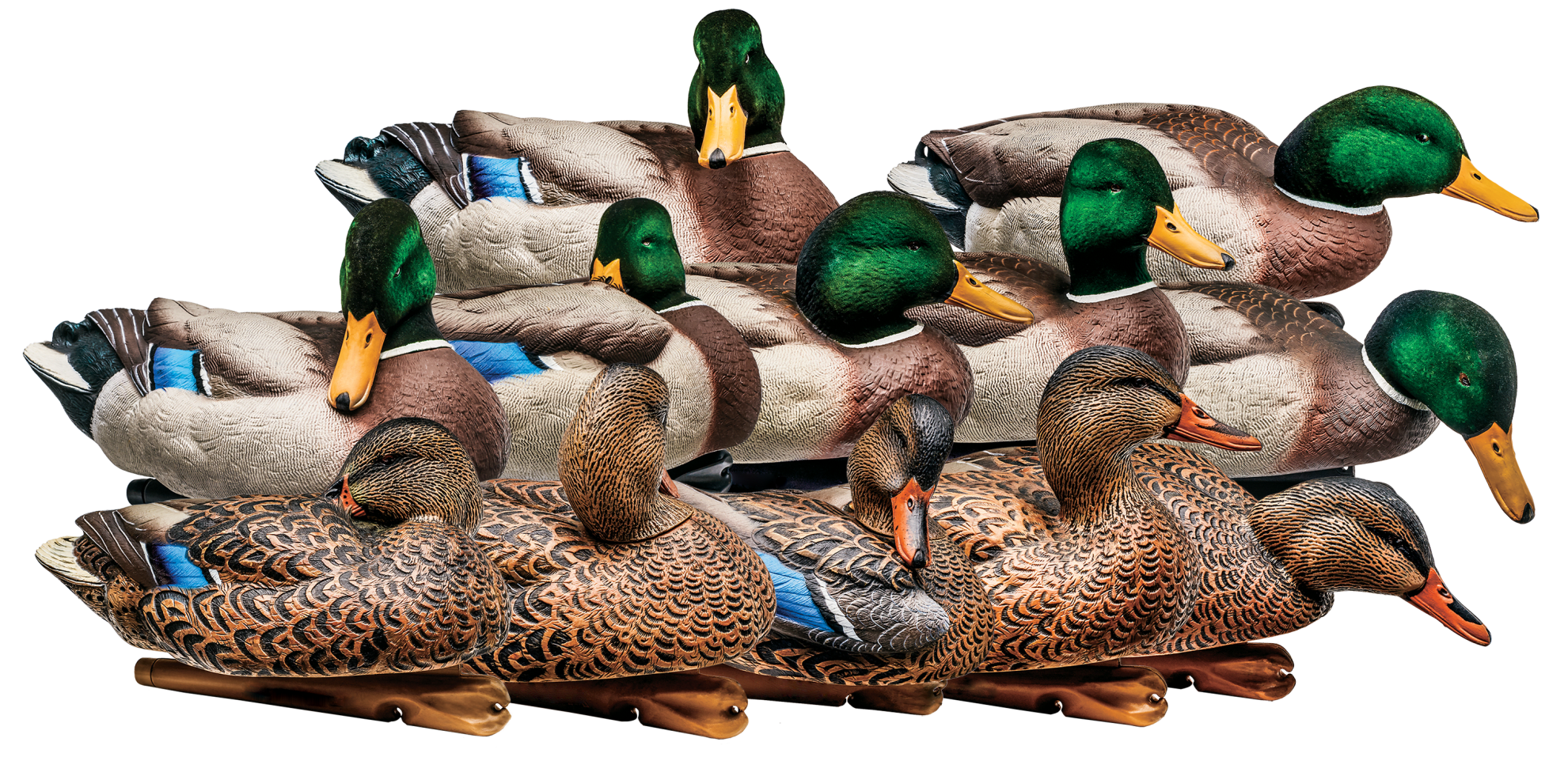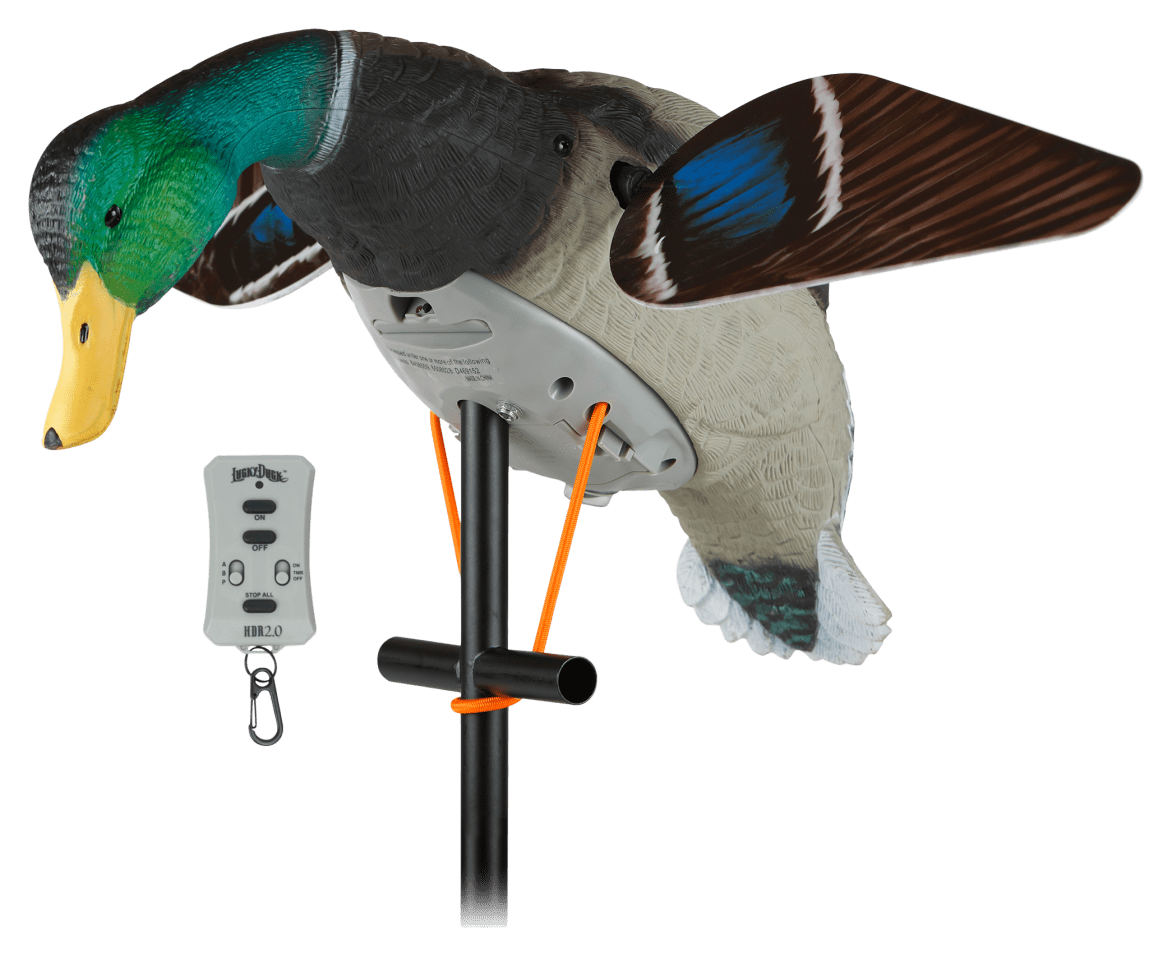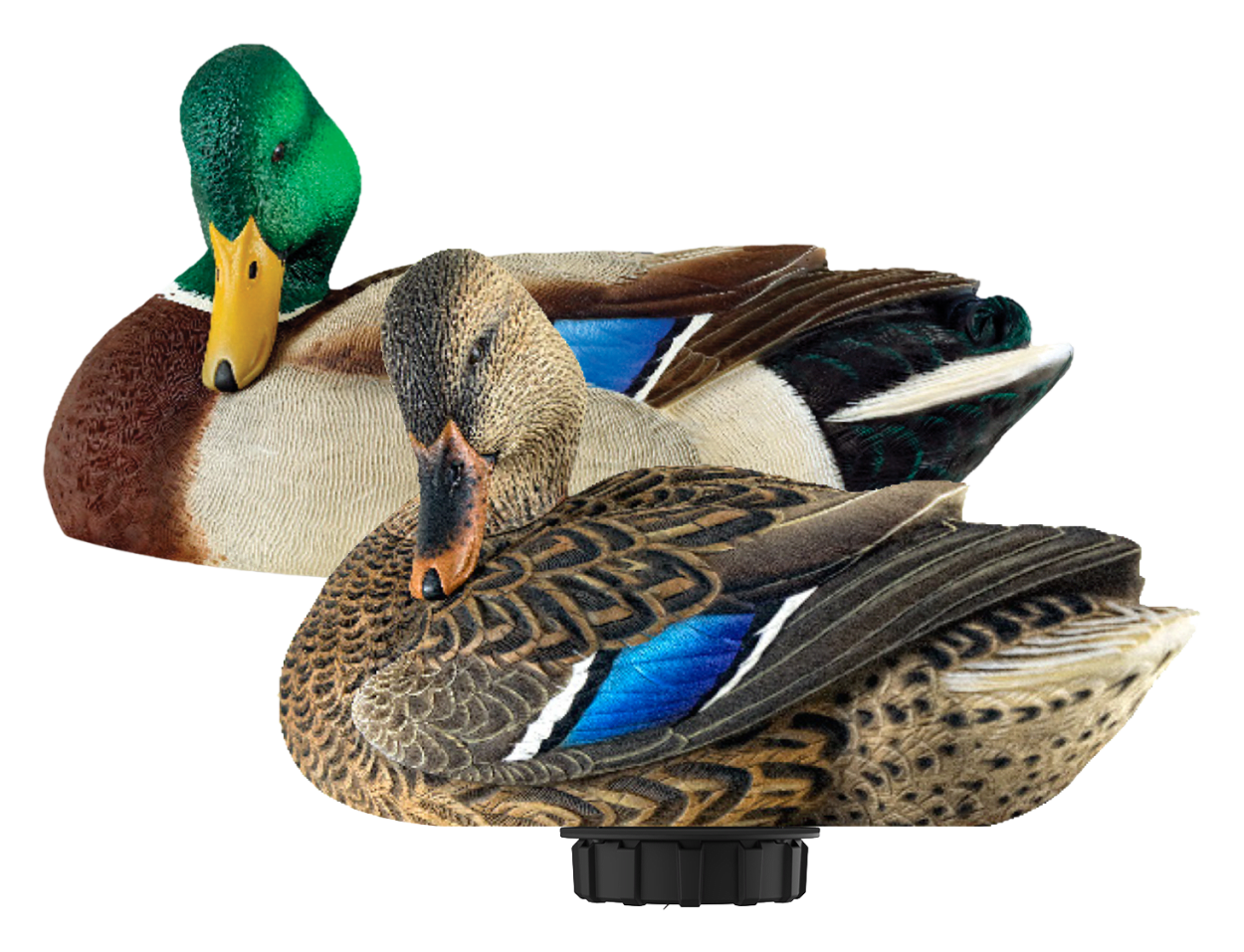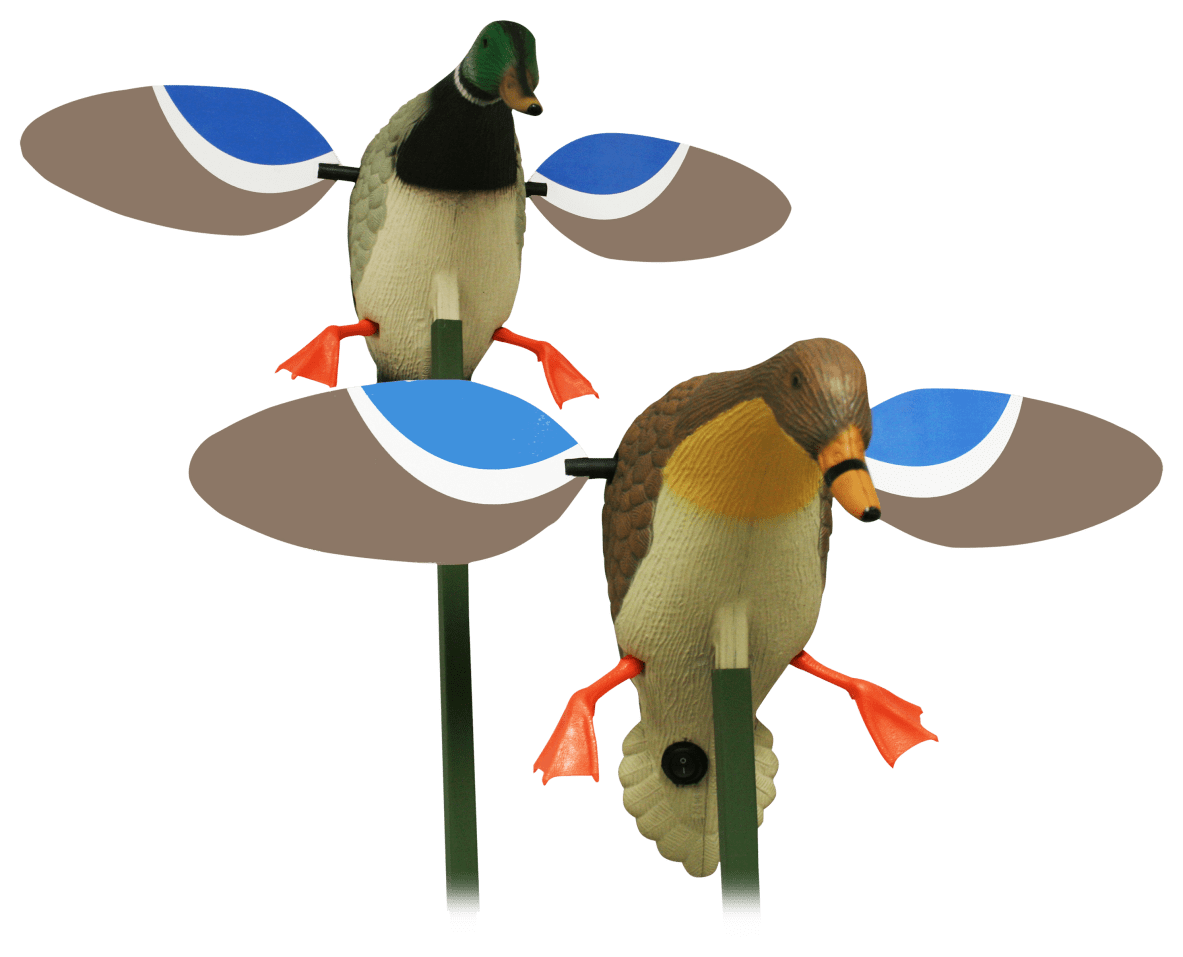
When it comes to waterfowl hunting, the right decoys can make or break your success in the field. Decoys are essential tools for attracting ducks and geese within shooting range, simulating a safe and inviting environment for them to land. Whether you're a seasoned hunter or just getting started, understanding the role of decoys is crucial to improving your odds.
There’s an ongoing debate among hunters about the effectiveness of static versus motion decoys. Static decoys, the traditional favorites, are known for their simplicity and reliability. On the other hand, motion decoys have gained popularity for their ability to mimic natural movements and add life to a spread. Both have their own set of advantages, and choosing between them can be a bit of a head-scratcher.
Benefits of Static Duck Decoys
Northern Flight Big Spread Life-Size Mallard Duck Decoys
Make it easier to set out a quality decoy spread at a great price with the Northern Flight® Big Spread Life-Size Mallard Duck Decoys. Made of a tough and flexible EVA/LDPE blend specially formulated for durability, these decoys deliver season after season of use and travel more quietly to and from the blind.
Shop NowWhen it comes to hunting, sometimes the simplest tools are the most effective. Static duck decoys have been a staple in waterfowl hunting for generations, and there's a good reason for that. Let's break down why these tried-and-true decoys continue to be a favorite among hunters.
Cost-Effective
For many hunters, especially those just starting out, budget is a big consideration. Static decoys are generally more affordable than their motion counterparts. You can get a decent number of static decoys for the price of a single motion decoy. This cost-effectiveness makes them ideal for beginners who are building their first decoy spread, or for seasoned hunters looking to expand their collection without breaking the bank. Plus, with fewer mechanical parts, the long-term cost of maintaining static decoys is minimal.
Durability
Hunting often means braving tough weather conditions and rugged terrain. Static decoys are built to withstand the elements. Made from durable materials, they can handle everything from freezing temperatures to heavy winds and rain. Their solid construction means they can take a bit of rough handling during transport and setup without getting damaged. This durability translates to a longer lifespan, offering more bang for your buck and ensuring that your investment lasts season after season with minimal upkeep.
Realism in Large Numbers
When it comes to creating a convincing spread, numbers matter. Static decoys excel in this area because you can deploy a large number of them to simulate a flock of ducks on the water. This is particularly useful in areas with high hunting pressure, where ducks have become savvy to smaller, less realistic spreads. By setting out a substantial number of static decoys, you can create the illusion of a safe, bustling environment that can lure in even the most cautious birds. The sheer volume of decoys can be particularly effective in open water or large fields, where visibility is key.
Avian-X Topflight Wood Duck Decoys
Avian-X™ Topflight Wood Duck Decoys have been passionately researched and reproduced for amazing lifelike quality. These true-to-life creations capture the beauty and grace of Wood Ducks, along with the personality and posture of waterfowl at rest. A unique weight-forward swim keel helps these hunting decoys achieve realistic swimming motion when attached to a line.
Shop NowAvian-X TopFlight Mallard Duck Decoy Outfitter Pack
Create an ultrarealistic spread this season with the wide variety of looks in the Avian-X® TopFlight® Mallard Duck Decoy Outfitter Pack. Packed with feeding, swimming, resting, and preening decoys, this ultra-realistic decoy set combine lifelike postures with lifelike paint schemes that include enhanced contrast for greater visibility through a variety of weather conditions.
Shop NowBenefits of Motion Decoys
Lucky Duck Lucky HD Motorized Duck Decoy with Remote 2.0
Heat up your duck hunting action this season with the highly defined, highly digital, and highly durable motion performance of the the Lucky Duck® Lucky HD™ Motorized Duck Decoy with Remote 2.0. This rugged and realistic spinning-wing decoy features rugged EVA plastic construction with an integrated chest mount to fit securely on the included 3-piece, 42" stake.
Shop NowMotion decoys have revolutionized the way we think about decoy spreads. These high-tech tools add an extra layer of realism and attraction that can make a significant difference in your hunting success. Let’s dive into the unique benefits of incorporating motion decoys into your setup.
Enhanced Realism
One of the standout features of motion decoys is their ability to mimic natural movements. Whether it’s a decoy that swims, feeds, or flaps its wings, the added motion creates a lifelike appearance that static decoys simply can’t match. Ducks are social creatures that rely heavily on visual cues to assess the safety and attractiveness of a landing area. When they see movement that resembles natural behaviors, it makes your spread look more like a real flock. This enhanced realism can be the key to convincing wary birds that it’s safe to join the party.
Attracting Attention
In the world of waterfowl hunting, catching a duck’s eye from a distance is half the battle. The subtle movements of motion decoys can make all the difference. A bit of splash or a flash of wings can grab the attention of birds flying overhead or far away. This can be particularly effective in drawing birds into shooting range that might otherwise pass by your spread. The dynamic motion acts like a beacon, signaling to ducks that there’s activity below worth checking out.
Versatility in Calm Conditions
We all know that some days are just too calm for traditional decoys to shine. On those still days when the water is like glass, your static decoys can look lifeless. Motion decoys come to the rescue by adding the necessary movement to your spread. Whether it’s a swimmer decoy creating ripples or a feeder decoy dipping its head, this motion can make your spread look active and inviting, even when Mother Nature isn’t cooperating.
Standing Out in Heavy Pressure Areas
In heavily hunted areas, ducks get smart fast. They start recognizing and avoiding the typical static decoy setups. This is where motion decoys can give you a serious edge. The added movement helps your spread stand out from the rest, making it look less like a hunter’s trap and more like a natural gathering of birds. This can be crucial in convincing educated birds to commit, giving you the upper hand in high-pressure hunting zones.
Interactive Spread
One of the coolest benefits of motion decoys is their ability to create an interactive spread. Different types of motion decoys can simulate various behaviors, such as swimming, feeding, or flapping. This interaction can make your entire setup look dynamic and engaging. Birds see other birds interacting and moving around, which can make your spread look more convincing and inviting. An interactive spread enhances the overall attractiveness and can draw in ducks that might otherwise be skeptical.
Avian-X Power Shaker Mallard Preener Motorized Duck Decoy Combo
Add the true-to-life motion and look of a pair of preening mallards to your spread with the Avian-X® Power Shaker Mallard Preener Motorized Duck Decoy Combo. Combining foam-filled bodies with Avian-X's patent pending motorized weight system that propels the decoy up and down instead of side to side, these preening drake and hen decoys deliver a lifelike motion and look.
Shop NowMOJO Outdoors Baby MOJO Hen and Drake Motorized Duck Decoy Combo
Maximize the MOJO magic in your decoy spread with the MOJO Outdoors® Baby MOJO® Hen and Drake Motorized Duck Decoy. Offering duck hunters all of the effectiveness of the MOJO Mallard® decoy in a smaller package, the Baby MOJO offers the same lifelike motion of a landing or lofting duck to draw in wary greenheads.
Shop NowWhen to Use: Static vs. Motion Decoys
Both static and motion decoys have their own strengths, and knowing when to use each type can significantly improve your hunting success. Let’s break down the ideal conditions for deploying static decoys versus motion decoys.
Conditions Favoring Static Decoys
Large Open Areas Where Numbers Are More Convincing
In vast open spaces such as large lakes or expansive fields, the sheer number of decoys can be more effective than intricate movements. Ducks flying overhead in these areas are looking for safety in numbers. Static decoys allow you to set up a large, convincing spread without the complexity or cost of motion decoys. The visual appeal of a big flock can be incredibly enticing to birds seeking a safe place to land.
Budget Constraints or When Simplicity Is Preferred
If you’re just starting out or need to keep costs down, static decoys are the way to go. They offer a cost-effective solution for building a sizable spread without breaking the bank. Additionally, their simplicity makes them perfect for hunters who prefer a straightforward, no-fuss setup. With fewer parts to worry about, static decoys are easy to transport, set up, and maintain, letting you focus on the hunt rather than the gear.
Conditions Favoring Motion Decoys
Calm Days with Little to No Wind
On those still, calm days when the water looks like glass, static decoys can appear lifeless and unconvincing. This is where motion decoys truly shine. A bit of movement can make all the difference in creating a lifelike spread. Whether it’s a swimmer decoy generating ripples or a feeder decoy dipping its head, motion decoys add the necessary activity to draw in curious ducks. They bring your spread to life, making it look natural and inviting even when there’s no wind to help.
Hunting in High-Pressure Areas with Educated Birds
In areas where ducks have been heavily hunted, they get smart quickly. These educated birds become wary of traditional static decoy spreads. Adding motion decoys to your setup can give you an edge in these high-pressure areas. The realistic movements of motion decoys can differentiate your spread from others, making it look less like a hunter’s trap and more like a natural gathering. This can be crucial in convincing cautious birds to come in for a closer look.
When Extra Realism Is Needed to Draw in Wary Waterfowl
There are times when ducks are particularly skittish or conditions are such that extra realism is required to seal the deal. This is when motion decoys become invaluable. Their ability to mimic natural behaviors like swimming, feeding, or flapping wings can add that extra touch of authenticity to your spread. This heightened realism can be the deciding factor in drawing in wary waterfowl that might otherwise pass by a static spread.
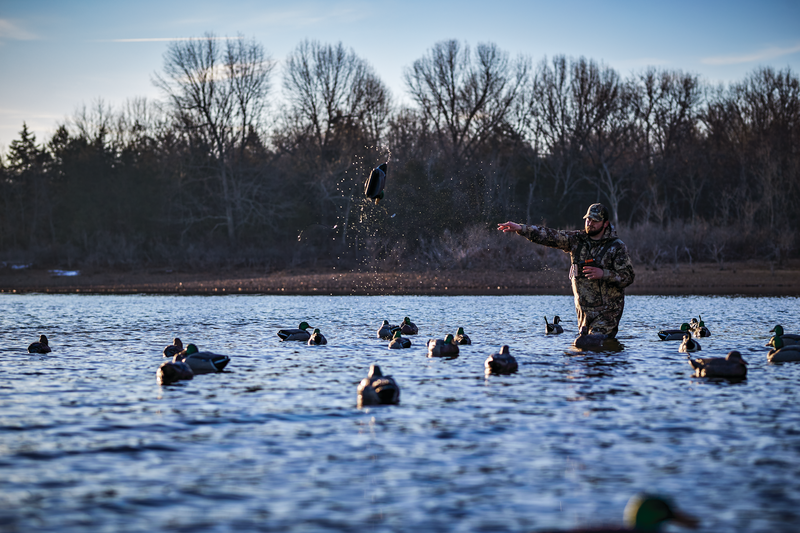
Final Thoughts
In the realm of waterfowl hunting, the choice between static and motion decoys isn't necessarily about picking one over the other, but rather understanding how to leverage each type's strengths to maximize your success in the field. Both static and motion decoys offer unique advantages that can be crucial depending on the specific conditions and challenges you face during your hunt.
Ultimately, the most effective decoy strategy often involves a combination of both static and motion decoys. By understanding the specific conditions that favor each type—such as using static decoys for large open areas and budget-friendly setups, and motion decoys for calm days and high-pressure zones—you can tailor your approach to create the most convincing and effective spread possible.
Experiment with different setups, observe how the birds respond, and adjust your strategy accordingly. The key is to remain adaptable and willing to tweak your spread based on the conditions and the behavior of the birds you're targeting. By doing so, you'll enhance your odds of a successful hunt and enjoy a more rewarding experience out in the field.
- 2682 views




